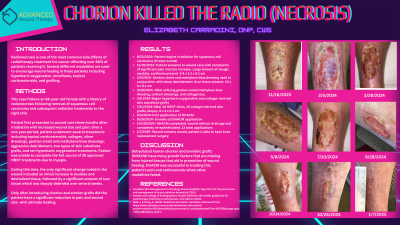Case Series/Study
(CS-024) Chorion Killed the Radio (Necrosis)
Friday, May 2, 2025
7:45 PM - 8:45 PM East Coast USA Time

Introduction: Radiation dermatitis is one of the most common side effects of radiotherapy treatment for cancer, affecting over 90% of patients receiving it. There are several different modalities that can be used to encourage wound healing in these patients, including hyperbaric oxygenation, topical corticosteroids, and grafting.
Methods: This case follows an 84-year-old female with a history of radionecrosis following removal of squamous cell carcinoma and subsequent radiation treatments to the right shin. Patient first presented to provider three months after irradiation with complaints of increase in wound size and pain. Over a one-year period, patient underwent several treatments including topical corticosteroids, collagen, silver dressings, gentian violet and methylene blue dressings, aggressive debridement, two types of skin substitute grafts. In addition, patient underwent ten hyperbaric oxygenation treatments but had to stop due to risks of ocular changes. Through these treatments, patient had no meaningful decrease in pain or wound size. Only after introducing chorion and amnion grafts did the patient have a significant reduction in pain and wound size.
Results: Patient began irradiation for squamous cell carcinoma 8/2023. Over a one-year period, the wound initially worsened in size and pain, then stalled while several different treatments were used including skin substitute grafts, hyperbaric oxygenation, and several different dressings. The only alleviation of pain and size was with application of dehydrated chorion and amniotic graft placement.
Initial measurements 11/2023- 5.4 x 3.2 x .1 cm-within one week we began to see more slough, and necrosis of tissue that was irradiated
2/2024-7.8 x 4.3 x.1 cm
May 2024-began hyperbaric oxygenation and skin substitute grafts
July 2024-6 x 3 x .1 cm
8/2024-first application of DHACM- 5.9 x 2.9 x .1 cm
Week 4 of DHACM application- 5.2 x 2.3 x .1 cm
Week 8 of DHACM- Tissue is completely re-epithelialized.
Discussion: Dehydrated human chorion and amniotic grafts (DHACM) have many growth factors that are missing from injured tissues that aid in promotion of wound healing. DHACM was successful in treating this patient's pain and radionecrosis successfully where other modalities failed.
Methods: This case follows an 84-year-old female with a history of radionecrosis following removal of squamous cell carcinoma and subsequent radiation treatments to the right shin. Patient first presented to provider three months after irradiation with complaints of increase in wound size and pain. Over a one-year period, patient underwent several treatments including topical corticosteroids, collagen, silver dressings, gentian violet and methylene blue dressings, aggressive debridement, two types of skin substitute grafts. In addition, patient underwent ten hyperbaric oxygenation treatments but had to stop due to risks of ocular changes. Through these treatments, patient had no meaningful decrease in pain or wound size. Only after introducing chorion and amnion grafts did the patient have a significant reduction in pain and wound size.
Results: Patient began irradiation for squamous cell carcinoma 8/2023. Over a one-year period, the wound initially worsened in size and pain, then stalled while several different treatments were used including skin substitute grafts, hyperbaric oxygenation, and several different dressings. The only alleviation of pain and size was with application of dehydrated chorion and amniotic graft placement.
Initial measurements 11/2023- 5.4 x 3.2 x .1 cm-within one week we began to see more slough, and necrosis of tissue that was irradiated
2/2024-7.8 x 4.3 x.1 cm
May 2024-began hyperbaric oxygenation and skin substitute grafts
July 2024-6 x 3 x .1 cm
8/2024-first application of DHACM- 5.9 x 2.9 x .1 cm
Week 4 of DHACM application- 5.2 x 2.3 x .1 cm
Week 8 of DHACM- Tissue is completely re-epithelialized.
Discussion: Dehydrated human chorion and amniotic grafts (DHACM) have many growth factors that are missing from injured tissues that aid in promotion of wound healing. DHACM was successful in treating this patient's pain and radionecrosis successfully where other modalities failed.

.jpg)